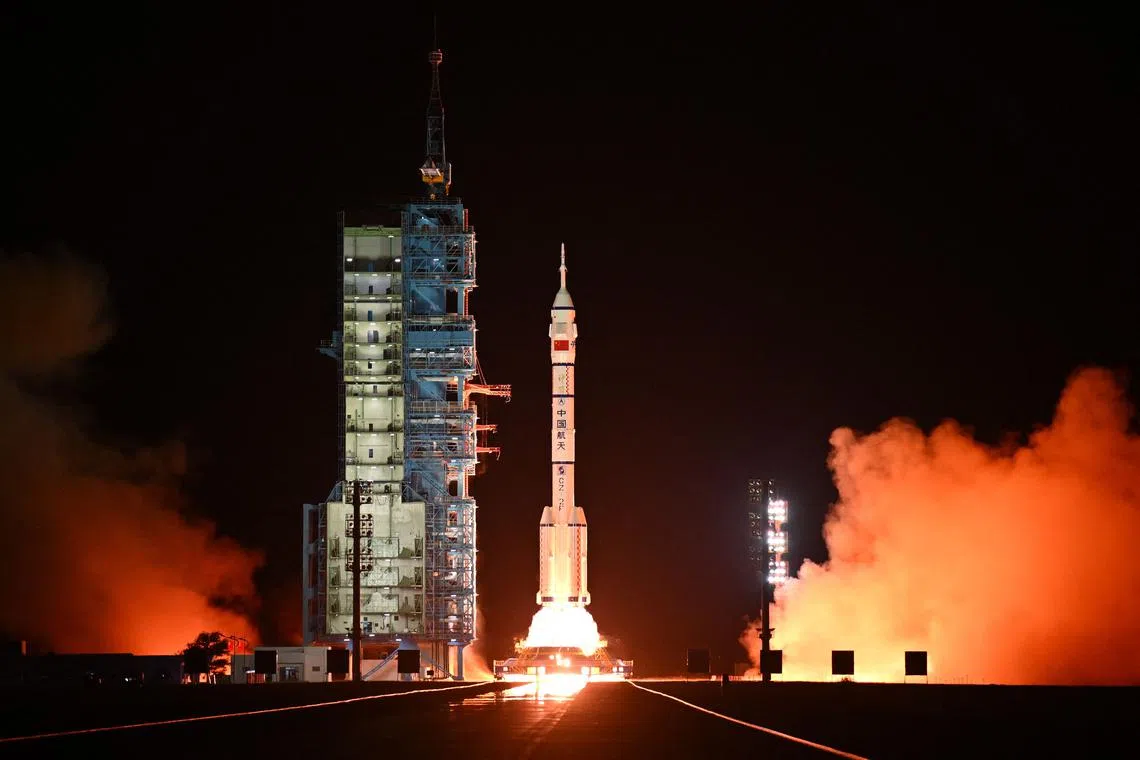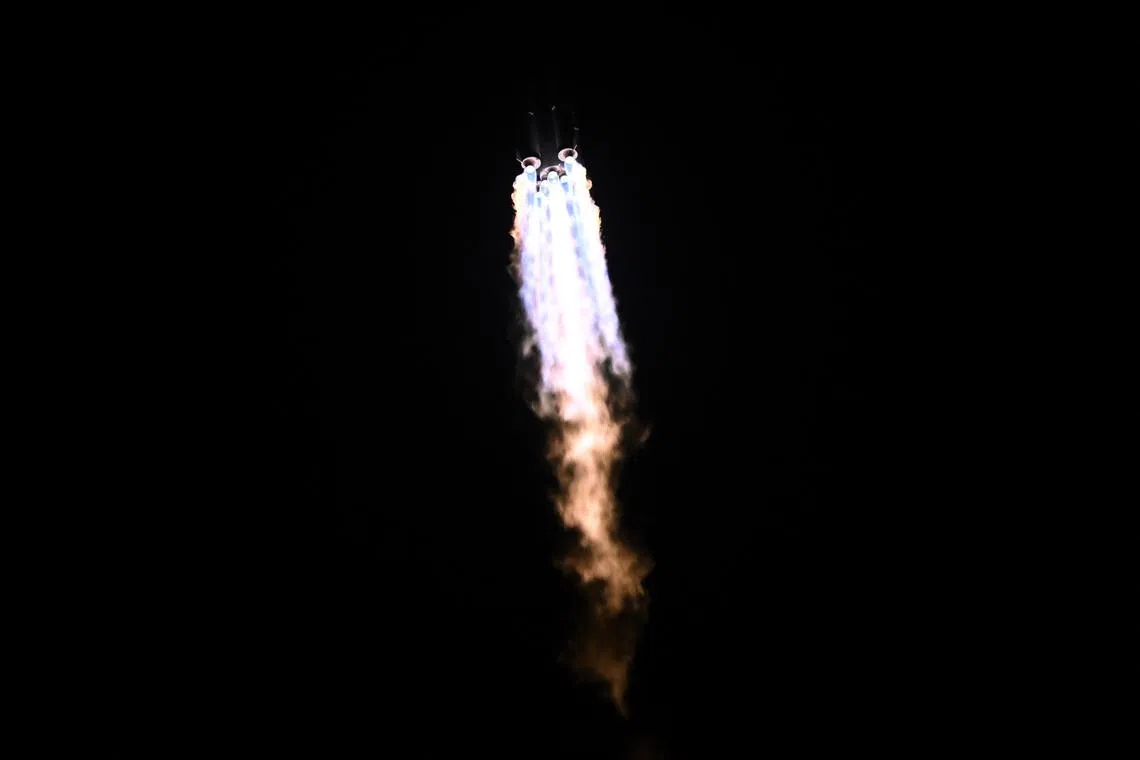Three-person crew starts ‘dream mission’ inside China’s Tiangong space station
Sign up now: Get ST's newsletters delivered to your inbox

Astronauts Cai Xuzhe (right), Song Lingdong (centre) and Wang Haoze waving to the crowd during a departure ceremony ahead of the launch.
PHOTO: AFP
Follow topic:
JIQUAN - Three Chinese astronauts, including China’s only female spaceflight engineer, entered the Tiangong space station on Oct 30 following an early morning launch into orbit.
The Shenzhou-19 mission took off with its trio of space explorers at 4.27am from the Jiuquan Satellite Launch Centre in north-west China, state news agency Xinhua and state broadcaster CCTV reported.
Among the crew is Lieutenant-Colonel Wang Haoze, 34, who is China’s only female spaceflight engineer, according to the China Manned Space Agency (CMSA). She is the third Chinese woman to take part in a crewed mission.
The crew arrived around 12.51pm and met with the astronauts from the previous Shenzhou-18 mission, “starting a new round of in-orbit crew handover”, state news agency Xinhua said.
The new Tiangong team will carry out experiments with an eye to the space programme’s ambitious goal of placing astronauts on the moon by 2030 and eventually constructing a lunar base.
“Like everyone else, I dream of going to the space station to have a look,” Lt-Col Wang told a media gathering on Oct 29 alongside her fellow crew members, lined up behind podiums and tall panes of glass to seal them off from the public.
“I want to meticulously complete each task and protect our home in space,” she said.
“I also want to travel in deep space and wave at the stars.”
The space agency deemed the launch a “complete success”, Xinhua said, adding that about 10 minutes after taking off, the spaceship separated from the rocket and entered its designated orbit.
Xinhua later said the spaceship had “made a fast, automated rendezvous and docking with the front port of the space station’s core module Tianhe at 11am”, and that the trio would then enter the module.
Headed by Senior Colonel Cai Xuzhe, the team will return to earth in late April or early May 2025, CMSA deputy director Lin Xiqiang said at a separate press event ahead of the launch.
Senior Colonel Cai, 48, brings experience from a previous stint aboard Tiangong as part of the Shenzhou-14 mission in 2022.
“Having been selected for the new crew, taking on a new role, facing new tasks and new challenges, I feel the honour of my mission with a great responsibility,” he said.
The aerospace veteran added that the crew was now “fully prepared mentally, technically, physically and psychologically” for the mission ahead.

A Long March-2F carrier rocket carrying the Shenzhou-19 spacecraft and crew of three astronauts lifts off from the Jiuquan Satellite Launch Centre.
PHOTO: AFP
Completing the astronaut line-up is 34-year-old fighter pilot Song Lingdong.
The CMSA’s Mr Lin said the crew currently aboard the Tiangong space station is scheduled to return to earth on Nov 4 after completing handover procedures with the incoming astronauts.
‘Space dream’
China has ramped up plans to achieve its “space dream” under President Xi Jinping.
Its space programme was the third to put humans in orbit and has also landed robotic rovers on Mars and the Moon.

The Long March-2F rocket carrying the Shenzhou-19 spacecraft and crew of three astronauts lifting off from the Jiuquan Satellite Launch Centre, in the Gobi Desert in north-west China, on Oct 30.
PHOTO: AFP
Crewed by teams of three astronauts that are rotated every six months, the Tiangong space station is the programme’s crown jewel.
Beijing says it is on track to send a crewed mission to the moon by 2030, where it intends to construct a base on the lunar surface.
The Shenzhou-19 crew’s time aboard Tiangong will see them carry out various experiments, including some involving “bricks” made from components imitating lunar soil, CCTV reported.
These items – to be delivered to Tiangong by the Tianzhou-8 cargo ship in November – will be tested to see how they fare in extreme radiation, gravity, temperature and other conditions.
Due to the high cost of transporting materials into space, Chinese scientists hope to be able to use lunar soil for the construction of the future base, CCTV reported.
Dr Jonathan McDowell, an astronomer at the Harvard-Smithsonian Centre for Astrophysics in the United States, told AFP that the Shenzhou-19 mission is primarily about “accumulating additional experience”.
While this particular swop of astronaut crews and upcoming six-month stint aboard Tiangong may not witness major breakthroughs or feats, it is still “very valuable to do”, said Dr McDowell.
China has in recent decades injected billions of dollars into developing an advanced space programme on a par with the US and Europe.
In 2019, China successfully landed its Chang’e-4 probe on the far side of the moon – the first spacecraft ever to do so.
In 2021, it landed a small robot on Mars.
Tiangong, whose core module launched in 2021, is planned to be used for about 10 years. AFP

